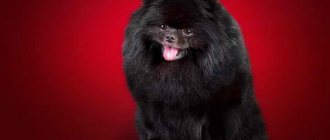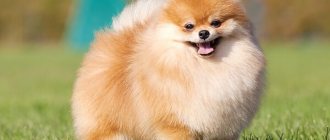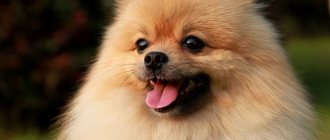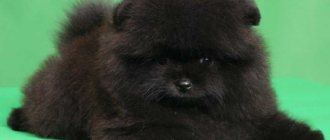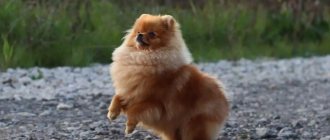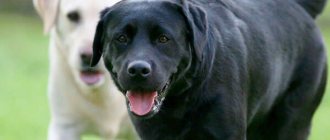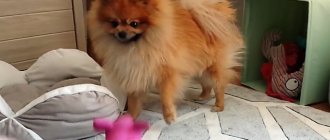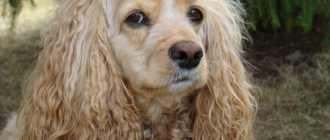Origin of the Black Pomeranian breed
Pomeranians originated in a region of Germany called Pomerania. At first these were large dogs that were used for protection, but after a while representatives of the nobility paid attention to them. Queen Charlotte, who married George III, brought a puppy with fluffy fur with her, which began the history of breed selection.
It is difficult to determine what color the ancestors of modern Pomeranians had, but the most common is considered to be a red tint - from fawn to brown. The color depends on a set of genes that determines the presence of a certain pymentum in the hairs - the charcoal shade is caused by a substance called eumelanin.
Individuals of uniform color are cultivated separately. To do this, babies are selected from litters that meet the necessary conditions, and then they are crossed with each other.
Sometimes genetics presents surprises to breeders - it is impossible to accurately predict the color of the fur of newborns.
Advantages of the breed
A sociable and loving pet will become a joy and motivator for active people. The micro-size of the dog will allow families to take the pet on all trips and travels. The sonorous barking of a dog will notify the owner of the approach of a stranger.
The dog's miniature size allows you to take it with you on trips
The Spitz will become a friend and companion for young people, and will also teach them to take care and show responsibility. Excellent natural immunity will allow the dog to live 15 years, full of joy and devotion to the owner.
The attractive appearance of the Spitz will make passers-by smile and the owner be proud of his baby.
Breed marriage
A small black Pomeranian does not necessarily have a uniform coat color - it is fully formed by about three years. In puppies, the hair can be brown or dark gray, and in adulthood it becomes charcoal or tan. A dog born from Pomeranians with a solid color may have small light hairs, which is not considered a defect. Early gray hair, which is possible in representatives of the breed, is also not considered a serious fault.
Defects are indicated when a black Mini Pomeranian has large spots of white or another shade visible on its coat.
Small German Spitz
Small German Spitz dogs with a square body are also called "Kleinspitz".
An amazing fact is that images of these animals have been found in many parts of the world: in Central Asia, Egypt, China and even Madagascar.
There is an opinion that small Spitz dogs are descendants of wolves, which may explain their ambiguous character.
Unlike the orange, it is less demanding to care for.
But despite minor differences, all German Spitz dogs are united by cheerfulness, curiosity, intelligence and endless devotion to their owner.
Orange color options
Dark Pomeranians have two color options: charcoal or black and tan. Each of them has standards that are taken into account when assessing the dog's characteristics.
Black
The shade of such individuals should be uniform, and the skin, nose, lips and undercoat also have a charcoal tint. It is not easy to obtain a similar color in puppies - if at least one of the ancestors deviates from this standard, there is a possibility that in the future the color will change, or tan marks will appear on the fur. Before shedding begins, brownish spots may appear on the fur, but after the natural process is completed, the orange will return to charcoal.
Black and tan look
A German Spitz with black fur and tan, that is, spots of a red or golden hue, also meets the breed standards. True, areas of a different color should be located in certain places:
- on the muzzle (above the eyes, in the lower part, on the inside of the ears);
- on the neck and chest;
- under the tail and on the paws.
Other colors, including tri-color or with an admixture of white (more than 50%) are outside the standard. Pomeranian Spitz with such hair are not allowed for exhibitions and breeding, but they look original and unusual.
Historical roots
The ancestors of the German Spitz with recognizable proportions and a fox-like muzzle lived in what is now Sweden. Their remains and images in the form of ornaments on utensils were discovered during excavations of ancient settlements. Archaeologists date it to the 8th-10th century BC. Written references to the Spitz were made in the 15th century; the dog is shown in them as a sociable and friendly dog. The German naturalist Fitzinger in 1867 wrote a description of 48 species of Spitz. In all his work, the dog is described as a friend and helper, protector and companion.
Friends of geniuses and nobles
In Germany, hounds began the selection of miniature Spitz dogs; the weight of the dwarf representatives was only 4 kilograms. “Spitz” is translated from German as “sharp” - the dog’s thin, recognizable muzzle is like the calling card of this breed, with the telling name “sharp”. Smart dogs with playful eyes and attractive bright fur coats began to conquer the boudoirs and palaces of noble people.
Sharp muzzle shape
Queen Victoria of England brought a mini-Spitz to England, which increased the popularity of these funny dogs, surprising in their size. She also became the first breeder of dwarf Spitz dogs in England. Royal pets have taken prizes at exhibitions since 1915, and the English club allowed dogs weighing no more than 3.6 kg into the exhibition. The most common colors at that time were sand, red and hazel.
In the famous work “The Lady with the Dog,” Chekhov described a Spitz dog, and in Charles de Coster’s novel “The Legend of Eulenspiegel” there were also dogs of this ancient breed. Famous owners of the breed were:
- Empress Catherine;
- Marie Antoinette;
- Michelangelo;
- Martin Luther;
- Mozart;
- Emil Sohl;
- Ludwig Richter.
With the development of transport in the world, the mini Spitz conquered America. Cynologists of this country have made a huge contribution to the development of the breed. "Americans" have a stable color, strong bones and easy movements. The coat of the representatives of the breed has a bright color and the necessary thick undercoat.
Dwarf Spitz dogs in France resemble the dogs of the past, they have long, pointed muzzles and large ears, but the body of individuals of this breed is large, which is bad for dwarfs.
In Russia, up to 50 German Spitz dogs were exhibited at major exhibitions in the 70s of the 20th century. After the fall of the Soviet Union, foreign representatives of the breed began to be brought into the country, which in 30 years completely replaced the old type of dogs.
Photos of old type dogs
Character Traits of a Black Spitz
Black Pomeranians have a lively, active and inquisitive character. They love to play and run, they are smart and quick-witted, so they are easy to train and become loyal friends for their owner.
Pomeranians' ancestors were guard dogs, and genetically determined traits show up in their diminutive descendants. Tiny German Spitz can come into conflict with large dogs and will not miss the opportunity to bark at a stranger who happens to be on their territory. Despite this, they get along well with other pets, including cats. True, the puppy must be raised correctly, otherwise it will become wayward and sometimes aggressive.
Characteristics of German Spitz
The external difference of German Spitz lies not only in the well-defined guard hair with a short thick undercoat, but also in the fluffy robe with a collar, which the dogs wear in the cold season and get rid of it only in the summer by molting.
Due to the large selection of growth varieties of Spitz dogs, they are often used in various fields of activity: such as security, homes, cargo transportation and even modeling.
A fit, friendly dog with a deep chest, high-set neck, free gait and graceful movements is difficult to confuse with any other breed.
Despite their endearing appearance, Spitz dogs have the hardy character of a hunter and devoted protector. They do an excellent job of protecting the territory of the house and its household members.
Advantages and disadvantages of the breed
Pomeranians are loyal, easy to train and friendly. Thanks to their thick coat, they do not freeze in cold weather and will be excellent companions for owners who lead an active lifestyle. Pomeranians are clean and can be trained to use a litter box or diaper. In addition, they have excellent hearing and can be used as guard dogs, and the advantage of the black coat is that the dog does not get dirty even in slushy weather.
The disadvantage of the miniature German breed is its cockiness and “loudness.” They bark constantly, especially if left alone, which can disturb their neighbors. The long fur of oranges also has a downside - it remains in the most unexpected places even after combing.
Possible problems with teeth, bones and joints - Pomeranians are prone to injuries and fractures.
Character
Energetic and life-loving dogs with a huge supply of energy can play on walks and at home; calmness and regularity are alien to their nimble character. Little wool balls are ready to support their owner on any journey, because it is not difficult for them to adapt to different conditions.
Dogs are quite active and can accompany their owner in any activity.
The German Spitz is suitable for active people who love sports and activity in their lives. These miniature dogs have a ringing bark that will be heard when danger approaches for the owner. Brave and cocky, they are able to start a fight with other animals, regardless of their small stature. A friend and guard with a sweet appearance will always support active games with the owner. The Spitz is suitable for people who attach great importance to appearance, but are also willing to spend time and effort caring for their pet.
Features of caring for a black Pomeranian
Caring for a black Pomeranian is not too complicated, but it has some nuances. The dog's ears, eyes and teeth should be examined and cleaned several times a week. For this purpose, products that are sold in a veterinary pharmacy and a special toothpaste are used. The claws are trimmed every 2-3 weeks with a special tool (nail clipper), otherwise they will grow too long and cause discomfort to the dog.
Grooming, combing
The goal of caring for the black Pomeranian's coat is to maintain its dark shade. It can change depending on various factors - changes in structure, environmental influences, nutrition, etc. In black and tan individuals, the changes are not too noticeable, but in the case of coal oranges, the difference will be striking.
The pet needs to be brushed twice a week (every day during shedding), and bathed as needed. It is advisable to use massage combs, and before the procedure, sprinkle the hair with water or a special product for dogs.
Bathing in the bath
Pomeranians do not require frequent bathing - hygiene procedures are carried out no more than twice a month, otherwise the pet's skin will dry out, which will lead to trouble. In cold weather, you should use dry shampoos, otherwise your mini dog may catch a cold. For individuals with a charcoal shade, it is recommended to use special products that improve color and prevent fading and browning.
Balanced nutrition for your pet
Pomeranians require a balanced diet - this can be ready-made food or natural products. Do not forget that food can affect coat color, so it is better to take recommendations from the breeder. It is recommended to give dark oranges nutritional supplements that improve pigmentation and hair quality.
Diseases and vaccinations
German Spitz are prone to diseases of the musculoskeletal system, problems with the trachea and breathing, epilepsy, and dental diseases. You can prevent troubles associated with characteristic pathologies with proper care and regular examinations by a veterinarian.
To prevent distemper, hepatitis, leptospirosis and other dangerous infections, puppies and adult dogs must be vaccinated on time.
Education and training
Representatives of the breed need to be trained from an early age. There is no need to use strict techniques - dogs are understanding and smart, so it is enough to say a few words in a stern voice. You should not allow aggression and selfishness, but reward good results with praise and treats.
Types and features
Today among miniature individuals there are:
- Dwarf, miniature, miniature Spitz and Pomeranian - these babies weigh 3 kg, height at the withers 20 cm.
- The Small Kleinspitz or Small German Spitz is also a small dog, but its height can already reach 29 cm and its weight is 5-10 kg.
One standard is described for all representatives of the breed, the only difference is in size and color.
Exhibition preferences
For owners, going to the first exhibition is a holiday, because receiving a description of their dog from a famous expert and hearing praise from the breed’s breeders is a great success. The expert in the ring will ask you to place the dog on a special table, where he will evaluate the following parameters:
To participate in the exhibition, you must comply with many conditions
- The physique should correspond to a 1:1 proportion. The length of the back is equal to the height of the dog at the withers.
- The head should be oblong, the muzzle should be narrow. A flat muzzle and a domed skull are not allowed.
- The dog has a bite. An undershot is not allowed (the lower jaw protrudes and hides the upper jaw).
- The height of the dog (from table to withers), depending on the type, is 18 cm - 29 cm.
- Pet color. Spots are not allowed on dogs of the same color. On spotted animals, the spots are located symmetrically.
The expert will then ask all participants to start moving their dogs around the ring. When evaluating animals at a trot, the judge will ask them to lag behind or overtake their partners in the ring, placing them in prize places. During the entire time the dogs are at the show, the judge evaluates the character and behavior of the dogs in the ring. Cowardice, loud barking, and aggression are considered disqualifying vices. The owners receive the final decision on who the winner is and a description of their pet after all the rings have ended, at the awards ceremony.
Nutrition
A small puppy should be fed up to 4 times a day, and an adult dog – 2 times and no more. Ideally, the feeding time will be the same every day - this is the only way the dog will not beg and overeat. Dry balanced food should be premium or super premium; holistic food is not suitable. If your choice is a natural menu, it should contain the following components:
- boiled lean meat: veal, chicken, turkey, beef;
- cereals: rice, buckwheat, rolled oats;
- boiled and raw vegetables;
- seafood;
- fruits;
- fermented milk: cottage cheese, kefir.
Your pet must always have access to clean drinking water. It is forbidden to feed a dog from the table - “human” food is higher in calories, and this breed is prone to obesity.
Peculiarities
The Small Spitz has a cheerful and mischievous disposition, loves to play and can frolic throughout the day. He is inquisitive and interested in everything around him. Despite its size, the Spitz is an excellent guard, thanks to its acute hearing. The baby is patient and allows even the smallest children to play with him. Only if he is hurt is the dog able to snap back or show aggression. The Spitz is very emotional, loves attention and affection, quickly grasps all commands on the fly and is easy to educate and train.
The dog does not tolerate loneliness well and it is better not to leave him alone for a long time. It is advisable to start socialization as early as possible, as the dog may be intimidated or afraid of loud noises and other things. Animals show caution towards strangers, but without aggression. The Spitz easily gets along with absolutely all pets: cats, dogs, rodents, birds. Their devotion to their loved one is enormous: the dog becomes very attached and has difficulty withstanding a change of owner.
Jealousy is inherent in kids: it is important for them to have a lot of attention and affection, otherwise selfishness breaks through in their character. If Spitz dogs don’t like something, they will openly tell everyone about it, even in front of strangers - loud and ringing barking should be taken into account when choosing a puppy for an apartment.
Description of the breed
The small German Spitz has a very attractive exterior: its muzzle is slightly pointed, like a fox's, which gives it a smiling expression. An incredibly beautiful fur coat cannot help but attract attention. Main appearance characteristics:
| Appearance | Characteristics |
| Head | wedge-shaped, small in size, with a pronounced stop. The nose is rounded, small, black for all color types except cream and brown; |
| Lips | smooth and tight, fit tightly, hiding white, even teeth. The jaws are full-toothed, well developed, scissor bite; |
| Cheeks | round and smooth, eyes of medium size, almond-shaped or oval. The eyelids are pigmented, black in all colors except chocolate; |
| Ears | erect, triangular in shape, set high. The neck widens towards the bottom, there is a slight bend, of medium length. There is a collar on the neck that is characteristic of the breed; |
| Frame | with high withers that flow smoothly into a straight and strong back. The loin is short and wide, the chest is well developed and deep. The stomach is well tucked; |
| Tail | medium length, set high, evenly pubescent. There is a crease on the back, maybe 1 or 2 curls; |
| Paws | Muscular and well-furred, widely spaced, strong. There are characteristic pants, paws in a ball. |
The animal's movements are confident and free, clear. The skin is dense, elastic and smooth. The head, paws, ears and the front side of the limbs are completely covered with hair. The undercoat is thick and fluffy, the top, axial hair is long.
How to raise a friend?
Training a small Spitz is a pleasure. Mini dogs have a sharp mind and passion when following commands. Difficulties may arise with encouragement. The small size of the dog does not allow it to eat a lot of treats. The dog becomes full and refuses to follow commands. It is important to learn how to play and reward your pet with fun games. With motivational training, seven repetitions are enough for a dog to learn one command. 15-minute lessons a day will be enough to learn the basics of obedience.
Consistency and complexity of actions, as well as the dog’s high interest in the game will also help with training. In case of negative reactions, for example, loud barking, it is enough to show the toy to distract the pet from the desire to bark.
Review from the owner of a dwarf Spitz:
How a shepherd protects me and the apartment from passers-by or other family members. Even if she is sleeping or engrossed in a game, she will always accompany her mistress where she is going and will definitely wait. Now he is slowly getting used to the sweater. He constantly hides food throughout the apartment, otherwise they won’t give it anymore). In general, I have never seen such a lively, sweet, smiling and intelligent dog, and I definitely recommend it to everyone.
Oksana
Photo of a spitz with a leaf-shaped toy

